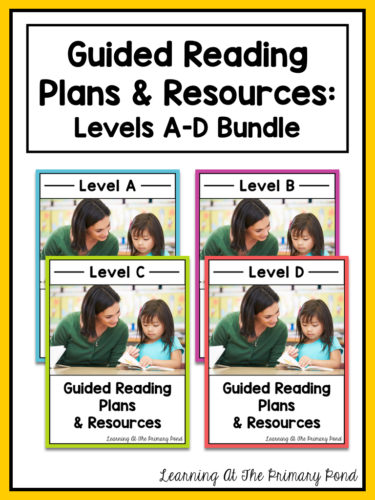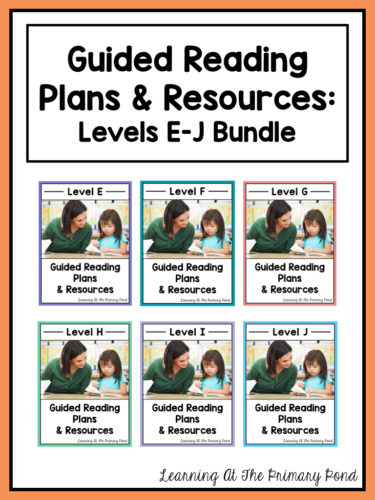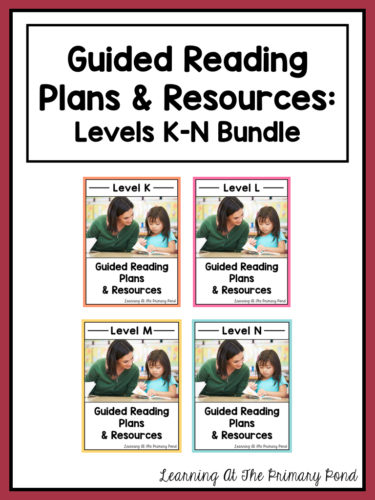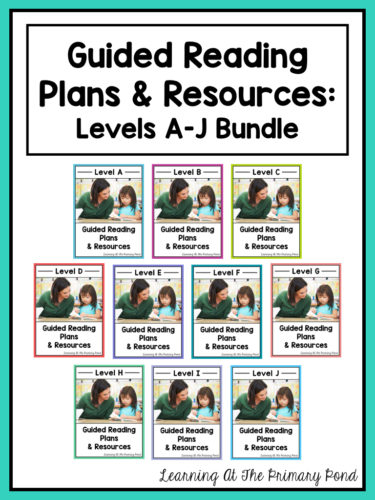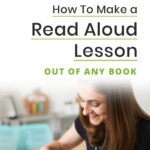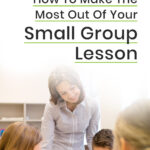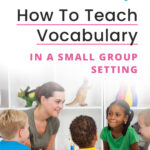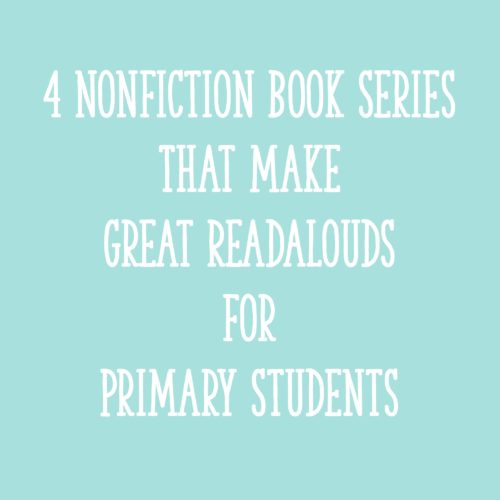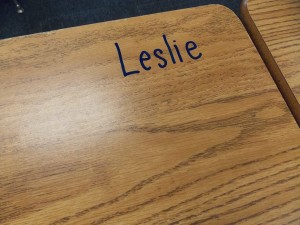Last week, I shared posts about how to introduce a text to students and how to effectively coach students during guided reading. Today’s post is all about what to do after students finish reading a text during guided reading – the post-reading conversation.
As I shared in the very first post in this series, after students finish reading a text, I always ask them to talk about its content.
I want to make sure that my students understand that making meaning is the ultimate goal of reading, so that’s why I usually address comprehension immediately.
However, if I have a super quick point to make about decoding (or students were making errors that could have interfered with them comprehending the book), I sometimes flip-flop these two components and discuss a reading strategy first.
In today’s post, I’ll go into more detail about the comprehension conversation and strategy instruction that I do after students finish a guided reading text. I’ll also share information about how I keep track of what strategies and skills I’ve taught each group.

Photo credit: DenisNata, Shutterstock
Note: This post contains Amazon affiliate links.
The Comprehension Conversation
After we finish reading the new text or selection for the day, I start up a comprehension conversation. I call it a conversation because I want to avoid the typical teacher-directed series of questions (it’s easy to fall back into that).
My ultimate goal is to create a genuine discussion that takes place between all students at the table. I don’t want to be the only one asking questions or bringing up topics. I want my students to respond to each other, question each other, and use the text to make meaning.
Does this happen in the first month of Kindergarten? Definitely not! (Probably not even in the sixth month, either…)
It takes a lot of time for students to learn to hold real conversations with each other. To do so, students have to learn to:
- Look at the speaker, not just the teacher
- Respond to each other’s comments
- Raise questions independently
- Independently reference the text when answering questions or responding to other students
I like to use sentence starters to help move students in this direction. At the most basic level, ones like “I think…” get them answering in complete sentences.
Then, you can move to using sentence starters like, “I think _____ because ______” (giving text evidence or support for their answers).
Next, you can transition to having them respond to each other: “I agree that __________ because ________.”
And eventually you can teach them to raise their own questions: “What do you think about ______?”
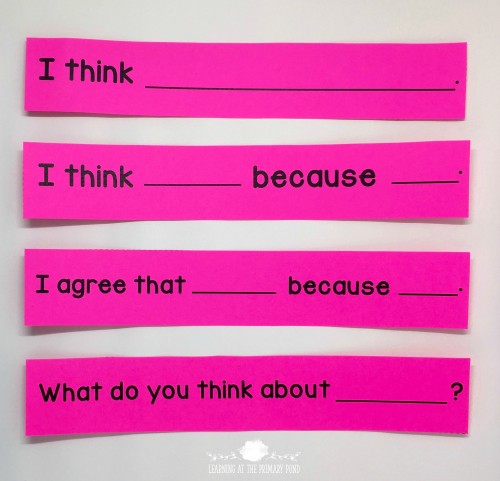
I spend several weeks having students practice responding with each type of sentence starter. I display the sentence starters and/or cut them up into strips, so each student has 1-2 on the table in front of him.
All of these sentence starters are included in my fee guided reading toolkit, which you can sign up to receive bly clicking on the image below:
Although I call it a comprehension conversation, sometimes you will need to do some explicit instruction during this portion of the lesson. Students who tend to “zone out” or not fully engage during whole group lessons will need a small group setting in order to learn comprehension /strategies.
So what strategies do I teach? Well, that depends. I tend to consider these three factors, in this order:
- Needs of the children in the guided reading group
- Overall goals of the whole-class reading unit or current lessons
- Demands of the text that students are reading
First and foremost, I consider the needs of the group. If it’s a group that has a tough time with retelling, for example, I do some modeling and/or have them practice retelling.
Second, I think about the goals of the reading unit that I’m working on with the whole class. Let’s say that we are studying nonfiction, and I’ve been teaching students how to synthesize the text and text features. If I can, I focus on this comprehension skill in my guided reading groups.
However, I don’t get super hung up on making sure that the whole class skill is EXACTLY the same one that I teach during small group instruction. I once worked at a school where I was forced to do this, and I found it to be detrimental to my students’ overall development as readers. Here’s why:
Let’s say that I’m working with a group of 2nd graders who are reading at a level G or H. This group of students is reading below grade level, and they have a lot of trouble with retelling and using the text while doing so.
In our whole class mini-lessons, we are working on stating the main idea of a nonfiction text. We use the most important details to state what the text is mostly about. We work on this skill for about 2 weeks.
If I bring that skill “down” to my small group guided reading and we ONLY talk about main idea for those two weeks, those 2nd graders at a level G/H are not having their needs met. Before they will be ready to pull out the main idea from a text, they need to be able to retell important details from the book, using the text.
Can I model stating the main idea during our small group instruction? Yes. Can I help move students toward that goal? Yes. (In fact, that’s exactly what I’m doing by teaching them to retell details using the text.)
But if I completely ignore their needs just for the sake of creating consistency throughout my literacy block, that’s not very flexible thinking on my part.
Anyway. Rant over.
The third thing I consider is the demands of the text level at which students are reading.
For example, if students are encountering dialogue for the first time, that’s something I’ll want to discuss during guided reading. Or if students are seeing text features for the first time, I incorporate that into our comprehension conversation.
The Continuum of Literacy Learning from Pinnell and Fountas is a great resource for figuring out what students at a given reading level are working on. I am also currently working on a Guided Reading resource series that shows you exactly what to teach at each reading level. You can check out Level A HERE.
To sum, during the comprehension part of my guided reading lessons…
- I work to make our comprehension discussion a true conversation
- I consider multiple factors when I choose comprehension skills to focus on
Strategy Instruction
After our comprehension conversation, I usually do a little decoding, fluency, or comprehension strategy instruction with students. During my strategy instruction, I seek to teach students something that they can use when reading the day’s text and other texts in the future.
I love the quote below, from the foundational text Guided Reading: Good First Teaching for All Children (Fountas & Pinnell, 1996). It expresses exactly what we should be thinking about when it comes to strategy instruction:
“What are children learning from this example that they can use in reading other texts?” (Fountas & Pinnell, 1996, p. 168)
Makes sense, right?
When I teach (or review) a strategy during this portion of the lesson, I try to go from specific to general. I start with an example from the text we just read, and then I talk about how students can apply that strategy to read other texts.
For example, let’s say I just read a Level A book with a group of Kindergarteners. The kids have a great vocabulary and are looking at the pictures, but they’re not consistently checking the first letter of an unfamiliar word.
I might start by saying something like: “When you guys were reading At The Zoo, you were really checking the pictures – that was great! You were thinking about what would make sense. But readers also have to check the first letter when they come to a word that they don’t know right away. Let me show you what I mean.” (Turns to a page in the text) “On this page, I saw Aaron check the picture AND the first letter. He read, I see a…and then he stopped. He looked at the picture and saw that it was a zebra. But he also looked at the first letter and said zzzz…and then he read zebra. Let’s practice this with another page.” (Turns to a different page without showing it to students, and covers up the picture.) “Let’s read this page together. I see a….” (Pauses to let students fill in the word by using the first letter.) “Now let’s check the picture! Yep, you were right – this page says, I see a tiger. You used the first letter, t, to figure out that the word was tiger, and we checked the picture, too. When you read books from your book boxes, or at home, you should use this strategy of checking the picture AND the first letter!”
I would also display some sort of visual to reinforce the strategy (this particular poster is from my Level A Guided Reading pack). I can display this same in the future to help them remember to use the strategy.
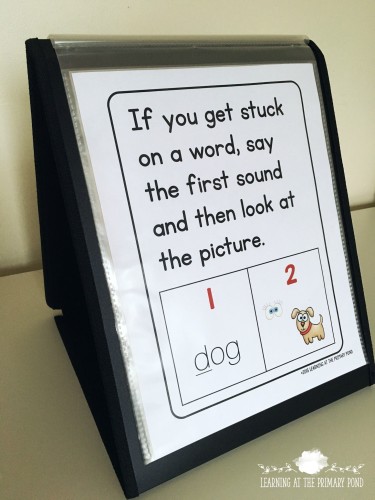
I love my tabletop stand – it has many sleeves for putting in strategy posters so I can change them quickly – you can find it HERE.
Anyway, in the example above, I pointed out how a student in the group used a strategy, gave a little bit of guided practice, and then encouraged students to use the strategy independently. I’d follow up by making sure that students are using the strategy in future guided reading groups and during their independent reading.
You might be thinking, that’s great, but how do I know what strategies to teach? Well, just like with comprehension, I consider the…
- Needs of the children in the guided reading group
- Overall goals of the whole-class reading unit or current lessons
- Demands of the text that students are reading
I also want to mention that I don’t always pick the strategy before I teach the group. Yes…that part of my lesson plan is sometimes blank. Gasp! 😉
I have a reason for this, though. Sometimes I want to see how students work with a text, and what strategies they are or are not using.
If, as they read the text, I see one child doing something that works GREAT, but the other students aren’t using this strategy, I almost always share it with the group. Or, if I see that none of the students are using a strategy that would have been super useful for the text, I take the opportunity to teach it.
There are a million different strategies that we could teach, and we have to be judicious about which ones we choose. In my free guided reading toolkit, I’ve provided a general list that you can use as a starting point. Maybe you’ll want to print it and keep it in your guided reading binder to have as a reference! To download the list, make sure you’ve signed up here:
Keeping Track of Everything
Although this post was long, the reality is that your comprehension conversation and strategy instruction have to be kind of short! All of this takes place in just a few minutes.
In addition to keeping it brief, we also have to keep this part of our guided reading lessons purposeful. That means that we need to keep track of what skills we’ve worked on with each child. Even when the kids sometimes switch groups. 😮
To keep track of what I’ve taught, I spend about 5 minutes each week filling in a spreadsheet. The spreadsheet is a quick way to track what skills and strategies I’ve taught over time, so I can make sure I’m not…
- Choosing strategies and bouncing around haphazardly
- Spending too long on one strategy, or
- Omitting certain essential strategies with a group of children or the whole class
Here’s an image of the editable skill tracking spreadsheet that comes with my Level A Guided Reading Resource Pack (you can see all the levels available by clicking HERE).
![]()
Do you have any tips for holding purposeful, focused discussions or teaching strategies during your guided reading groups? Please share below! And check back tomorrow for a post about follow-up activities for guided reading (including word work and writing).
Looking for more guided reading resources? Check out my bundles below, or click HERE for additional bundle options and individual leveled packs!
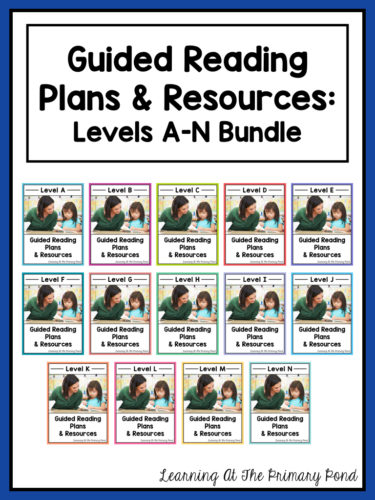
Update – the guided reading series is now complete! Check out the posts here:
How to Craft Strong Book Introductions for Guided Reading
How to Effectively Coach Students During Guided Reading
10 Post-Reading Activities for K-2 Guided Reading Lessons
Overcoming The Guided Reading Time Crunch
Resources:
Fountas, I. C., & Pinnell, G. S. (1996). Guided reading: Good first teaching for all children. Heinemann, 361 Hanover Street, Portsmouth, NH.
Richardson, J. (2009). The next step in guided reading: Focused assessments and targeted lessons for helping every student become a better reader. Scholastic Incorporated.
*The authors of this text are in no way affiliated with this blog – I am referencing their work as a means of explaining and supporting the ideas I set forth in this post.*


